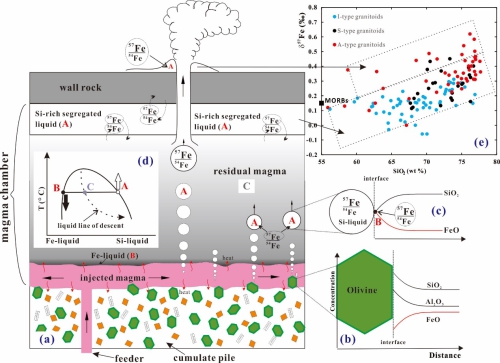Stable isotope geochemistry booms in the last 70 years due to the pioneering work proposed by Urey, Bigeleisen and Mayer, and isotope fractionation during equilibrium process is among the most-studied topics all these years. However, in recent years, increasingly published data suggest that equilibrium isotope fractionation theory is no longer capable to account for all these data. For example, equilibrium isotope fractionation of iron isotope in silicate melts is expected to be small at magmatic temperature, but an increasing number of data indicates that iron isotope shows a large variable range. In order to study these puzzling data, we need a theory of non-equilibrium process which unfortunately has not been established yet.
Recently, Profs. ZHU Dan, LIU Yun and BAO Huiming of the State Key Laboratory of Ore Deposit Geochemistry (SKLODG) at the Institute of Geochemistry, Chinese Academy of Sciences (IGCAS) have performed a theoretical study on the dynamic diffusion-induced isotope fractionation in immiscible silicate melts.
The scientists deduced theoretical equations and proposed a model, in which Si-melts nucleate at interfaces of olivine, and can grow larger because they are chemically far from equilibrium with the bulk melt and Si-melts rise to the top of a magma chamber due to their lower density (Fig. 1). The model successfully explains the Fe, Mg, Si and Li isotopic compositions of some A-type granitoids. This model also implies that diffusion-induced isotope fractionation may be more common in igneous processes than that was originally predicted, such as in erupted volcanic gases or in carbonatites.
The results have been published on Scientific Reports: Zhu, D., Bao, H., Liu, Y. (2015). Non-traditional stable isotope behaviors in immiscible silica-melts in a mafic magma chamber. Scientific reports, 5. 17561; doi:10.1038/srep17561 and can be accessed at: http://www.nature.com/articles/srep17561.
|

|
|
Fig. 1. Model for the origin of A-type granitoids in silicate melts. (a) Schematic illustration of unmixing process in a magma chamber; (b) Schematic illustration of SiO2、Al2O3, and FeO compositional profiles during rapid growth of an olivine crystal; (c) Schematic illustration of Fe isotope of interfacial melt and compositional profile during the convection growth of ascending Si-rich liquids; (d) compositions of the two liquids are connected by the horizontal line; the dashed line shows the liquid line of descent of the bulk liquid composition during crystallization; (e) Fe isotope composition of granitoids. ( Image by IGCAS) |
Contact:
ZHU Dan
Institute of Geochemistry, Chinese Academy of Sciences E-mail:
zhudan@vip.gyig.ac.cn(By GAO CaiHong)